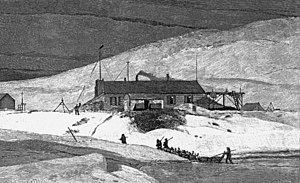| Fort Conger | |
|---|---|
| Grinnell Land, Ellesmere Island, Canadian Arctic | |
 Fort Conger in May 1883 | |
| Coordinates | 81°45′N 64°45′W / 81.750°N 64.750°W[1] |
| Type | Scientific research post |
| Site information | |
| Operator | United States Army Signal Corps |
| Site history | |
| Built | August 1881 |
| In use | 1881–1935 |
| Materials | Wooden boards; tar paper |
| Events | Lady Franklin Bay Expedition |
Fort Conger is a former settlement, military fortification, and scientific research post in the Qikiqtaaluk Region, Nunavut, Canada. It was established in 1881 as an Arctic exploration camp,[2] notable as the site of the first major northern polar region scientific expedition,[3] the Lady Franklin Bay Expedition, led by Adolphus Greely as part of the United States government's contribution to the First International Polar Year. It was later occupied by Robert Peary during some of his Arctic expeditions.
Fort Conger is located on the northern shore of Lady Franklin Bay in Grinnell Land, northeastern Ellesmere Island within Quttinirpaaq National Park. Bellot Island lies across from Fort Conger within Discovery Harbour. Though lacking in timber, the area is characterized by grasses and sedges. The surroundings are rugged and boast high cliffs around the harbour. Now uninhabited,[4] it is one of only a handful of previously staffed stations in the Queen Elizabeth Islands. In 1991, some of the structures at Fort Conger were designated as Classified Federal Heritage Buildings.[5]
- ^ "Fort Conger". Geographical Names Data Base. Natural Resources Canada.
- ^ "PEARY IS AT FORT CONGER" (PDF). The New York Times. November 10, 1900. Retrieved 2009-05-06.
- ^ George, Jane (4 August 2000). "Fort Conger: old tales of futility and desperation". Nunatsiaq News. Archived from the original on 8 October 2011. Retrieved 27 February 2010.
- ^ "Lady Franklin Bay". The Columbia Gazetteer of North America. bartleby.com. 2000. Archived from the original on 2005-11-27. Retrieved 2009-05-06.
- ^ "Quttinirpaaq National Park of Canada". pc.gc.ca. Retrieved 27 February 2010.
